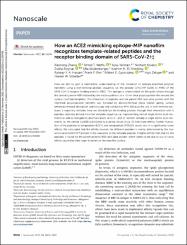| dc.contributor.author | Zhang, Xiaorong | |
| dc.contributor.author | Waffo, Armel T. | |
| dc.contributor.author | Yarman, Aysu | |
| dc.contributor.author | Kovacs, Norbert | |
| dc.contributor.author | Bognar, Zsofia | |
| dc.contributor.author | Wollenberger, Ulla | |
| dc.contributor.author | El-Sherbiny, Ibrahim M. | |
| dc.contributor.author | Hassan, Rabeay Y. A. | |
| dc.contributor.author | Bier, Frank F. | |
| dc.contributor.author | Gyurcsanyi, Robert E | |
| dc.contributor.author | Zebger, Ingo | |
| dc.contributor.author | Scheller, Frieder W. | |
| dc.date.accessioned | 2023-03-12T16:13:21Z | |
| dc.date.available | 2023-03-12T16:13:21Z | |
| dc.date.issued | 2022 | en_US |
| dc.identifier.uri | https://hdl.handle.net/20.500.12846/708 | |
| dc.description.abstract | Here we aim to gain a mechanistic understanding of the formation of epitope-imprinted polymer nanofilms using a non-terminal peptide sequence, i.e. the peptide GFNCYFP (G485 to P491) of the SARS-CoV-2 receptor binding domain (RBD). This epitope is chemisorbed on the gold surface through the central cysteine 488 followed by the electrosynthesis of a similar to 5 nm thick polyscopoletin film around the surface confined templates. The interaction of peptides and the parent RBD and spike protein with the imprinted polyscopoletin nanofilm was followed by electrochemical redox marker gating, surface enhanced infrared absorption spectroscopy and conductive AFM. Because the use of non-terminal epitopes is especially intricate, here we characterize the binding pockets through their interaction with 5 peptides rationally derived from the template sequence, i.e. implementing central single amino acid mismatch as well as elongations and truncations at its C- and N- termini. Already a single amino acid mismatch, i.e. the central Cys488 substituted by a serine, results in ca. 15-fold lower affinity. Further truncation of the peptides to tetrapeptide (EGFN) and hexapeptide (YFPLQS) results also in a significantly lower affinity. We concluded that the affinity towards the different peptides is mainly determined by the four amino acid motif CYFP present in the sequence of the template peptide. A higher affinity than that for the peptides is found for the parent proteins RBD and spike protein, which seems to be due to out of cavity effects caused by their larger footprint on the nanofilm surface. | en_US |
| dc.language.iso | eng | en_US |
| dc.publisher | Royal Society of Chemistry | en_US |
| dc.relation.isversionof | 10.1039/d2nr03898f | en_US |
| dc.rights | info:eu-repo/semantics/openAccess | en_US |
| dc.subject | Imprinted Polymers | en_US |
| dc.subject | Baskılanmış Polimerler | en_US |
| dc.subject | Geprägte Polymere | en_US |
| dc.title | How an ACE2 mimicking epitope-MIP nanofilm recognizes template-related peptides and the receptor binding domain of SARS-CoV-2 | en_US |
| dc.type | article | en_US |
| dc.relation.journal | Nanoscale | en_US |
| dc.identifier.volume | 14 | en_US |
| dc.identifier.issue | 48 | en_US |
| dc.relation.publicationcategory | Makale - Uluslararası Hakemli Dergi - Kurum Öğretim Elemanı | en_US |
| dc.contributor.department | TAÜ, Fen Fakültesi, Moleküler Biyoteknoloji Bölümü | en_US |
| dc.contributor.institutionauthor | Yarman, Aysu | |
| dc.identifier.startpage | 18106 | en_US |
| dc.identifier.endpage | 18114 | en_US |
| dc.identifier.wosquality | Q1 | en_US |
| dc.identifier.scopusquality | N/A | en_US |
| dc.identifier.wos | WOS:000892545400001 | en_US |

















